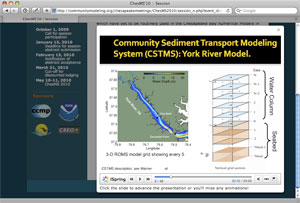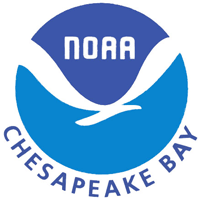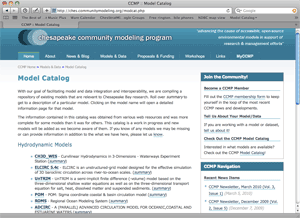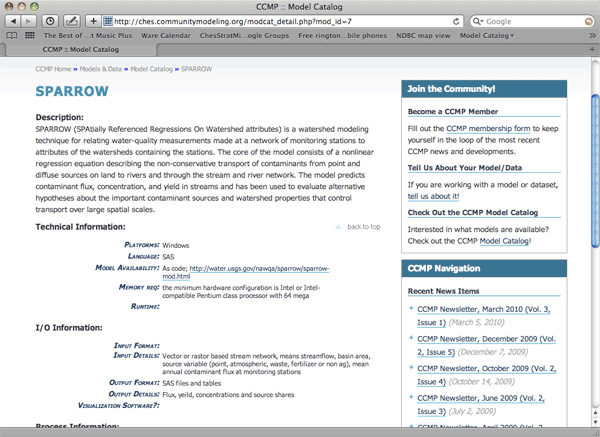Chesapeake Community Modeling Program
the CCMP Newsletter | May 2010
Introduction
Greetings! The dust has settled and the Chesapeake Community Modeling Program is reflecting on what was, by all accounts, a successful Chesapeake Modeling Symposium. The Symposium took place May 10-11 at the Annapolis Doubletree Hotel and was attended by over 150 people representing over 40 institutions from 12 states and Sweden.
This issue of the CCMP Newsletter is dedicated to providing a overview of the Symposium.

| Download the program |
Contents
1. Symposium in Review
2. Model Catalog
3. CCMP News
1. Symposium in Review
Presentations and Program Online
 |
| View the presentations online. |
The large number of sessions over 2 days required multiple concurrent sessionsand you may have missed a presentation or two because of schedule conflicts. Hence, we are in the process of making as many of the presentations as possible viewable online. Go here and click on the session you are interested in. This will take you to the session page where you will see a list of the presentations for that session. If the presentation is available, you will see a link for “View Presentation” or “View pdf”. You can also click on the presentation title to view the abstract. The program for the Symposium, including abstracts for all resentations, is available here.
Are you a presenter and don’t see your presentation? Please contact Dave Jasinski.
 What did you think of the Symposium?
What did you think of the Symposium?
If you haven’t already, please give us your evaluation of the Symposium. It will only take a couple minutes, it’s anonymous, and your responses will help CCMP meet or exceed your expectations for the next Symposium. To fill out the survey, please go here.
Session Summaries
Couldn't make it to the Symposium? We've asked each of the session convenors to develop a short summary of their session, highlighting key points of interest and discussion. Links to the sessions are included.
Future Technologies of Numerical Modeling of Chesapeake Bay - Frank Aikman III, Richard Patchen, Lyon Lanerolle, Raghu Murtugudde and Raleigh Hood (link)
This session provided a forum and opportunity for investigators to present their efforts and findings associated with physical (hydrodynamic) and ecological (biochemical) modeling and technology advances. It did initiate a dialogue regarding what technologies are the most critical to the next generation of Chesapeake Bay numerical modeling setups but it fell short of developing plans for the best options for future projections of Chesapeake Bay circulation, ecosystem health, and interactions with land use changes and other human activities.
Talks in this session covered a number of modern numerical modeling techniques, technologies and applications in the Chesapeake Bay region. These included:(...read more)
Simulating the shallows: Development and application of models for the Chesapeake’s fringing sub-littoral zone - - Mark Brush and Lora Harris (link)
The goal of the session was to demonstrate the range of activities in shallow water modeling in the Chesapeake region, with the goal of identifying active and needed areas of research. The session had four presentations, one by Carl Cerco on the shallow water component of the Chesapeake Bay Program model, one by Jian Shen on a range of simple to complex modeling approaches to Thalia Creek, a system in the lower Chesapeake, one by Jessie Jarvis on development of an eelgrass seed and seedling submodel to include the role of sexual reproduction in SAV models, and one by Mark Brush on application of simplified watershed and estuarine models to the lagoons of the Delmarva Peninsula. These talks presented a nice range of modeling goals from research to management, a broad range of approaches from simple to complex, and a broad range of topics from watershed loading to water quality and benthic microalgae to eelgrass. While the small size of the session may indicate low activity in shallow water modeling in the bay, an active discussion following the talks stressed the need for increased attention to the shallows despite the difficulty in modeling these dynamic systems.
Coping with Uncertainty in Modeling Environmental Resources: Practices, Pitfalls & Recommendations from Modelers, Restoration Biologists & Managers - - Tom Ihde and Howard Townsend (link)
At our full-day Session, we had an extremely interesting and engaging day. This Session was a professionally-facilitated panel discussion structured to produce a list of key challenges and initial steps for moving forward on this difficult issue for Bay fisheries management. Participating on the panel were both key managers and modelers from the region with a diverse knowledge and experience in Chesapeake Bay issues; these included: representation from the newly-formed Fisheries Goal Implementation Team (GIT), NOAA’s Chesapeake Bay Office, Maryland DNR, the Atlantic States Marine Fisheries Commission; faculty of the Virginia Institute of Marine Science, and the University of Maryland Center for Environmental Science (both Chesapeake Biological and Horn Point Laboratories); as well as consultants from Versar, Inc. and the Gentner Consulting Group, who possess a wide variety (...read more)
Design and Use of Environmental Observatories and Observing Systems for Estuaries - William P. Ball, Lewis C. Linker, and Doug Wilson (link)
Environmental observatories and observing systems are under continuing development as platforms for data acquisition, storage, and analysis to support a wide variety of potential users, including research scientists, resource managers, educators, commercial operations, and the public at large. A well-designed observatory enhances the opportunities for interaction between observational data and models of multiple types.(...read more)
Monitoring and modeling land change for hydrologic and ecosystem models: The way forward - Claire Jantz (link)
This session focused on land change monitoring and modeling, and included presentations by Eric Brown de Colstoun (NASA), Fred Irani (USGS), Claire Jantz (for Scott Goetz, WHRC), Kathy Boomer (for Xulong Li, SERC), Peter Claggett (USGS), Leslie Milheim (USGS), Marcela Suarez-Rubio (UMCES), Glenn Moglen (Virginia Tech), Claire Welty (UMBC-CUERE), and David Donato (USGS). Each presenter highlighted specific challenges related to monitoring and modeling land change for hydrologic or ecosystem models. For example:(...read more)
Exceptional Atmospheric and Hydrodynamic Processes and Events: Observations, Models, Forecasts, Response, and Communication - Elizabeth Smith (link)
The goal of this session was to explore a myriad of forecasting and observing tools to aid decision-makers and planners in understanding, predicting, and communicating extreme events in the Chesapeake Bay. Two dominant themes emerged from this session. The first was that the importance of a strategic suite of atmospheric (especially measurements of wind and precipitation) and oceanographic observations in Chesapeake Bay to aid in model initialization and especially validation should not be underestimated. The second theme was that in order to be able to predict and/or respond to extreme events such as tropical storms or oil spills, the existing observational network must be very much more integrated and the data better aggregated to allow for a more rapid (real-time or nearly so) sharing of data and information across a robust network.
CBP Model Application to Local TMDLs and Assessments of the Chesapeake Bay TMDL Water Quality Standards - Lewis Linker and Jing Wu (link)
The TMDL of the Chesapeake Bay is the first TMDL developed for a large aquatic ecosystem and the largest TMDL yet developed. Within the regional Chesapeake TMDL, thousands of local TMDLs are being developed by the Bay Program States. Coordination of the Bay TMDL and the local TMDLs with a community modeling approach as supported by CCMP allows for efficient governance, cost savings, and greater environmental protection. The community models, like the Phase 5 Watershed Model, provide a tool kit for local TMDL development. In our session we explored aspects community model application including an application of the community model to Maryland TMDLs (Dalmasy); an application that looked to assess drinking water resources under climate change stress (Schultz); and an interesting application of a watershed load assessment (Boomer) as seen though the eyes of a model practitioner and a planning board member – hint: they were the same person!
Regional Model Comparison: Mixing/Vertical Stratification in Chesapeake Bay - Wen Long, Ping Wang and Kevin Sellner (link)
This session was a focused study on the inter-comparison of the results of 4 models of the Chesapeake Bay with observational data. The over-arching goal was improving our understanding and predictive skills of salinity and temperature stratification structure of the Bay. The models examined during this session were CH3D (Wang, EPA Chesapeake Bay Program), EFDC (Shen, Virginia Institute of Marine Science), ChesROMS (Long et al., Univ of Maryland) and CBOFS2 (Lanerolle et al., NOAA). The comparison study and session presentations were coordinated to ensure consistent comparisons were made across the models using identical datasets. The later half of the session consisted of a 2 hour discussion among session attendees. The following items have been identified as important issues to follow up:(...read more)
Chesapeake Bay Ecological Forecasting: Moving ecosystem modeling from research to operation - Raleigh Hood, Robert Wood, David Green and Xinsheng Zhang (link)
Despite decades of ecosystem modeling efforts, ecological models are rarely taken to the operational phase. Operational ecosystem modeling and ecological forecasting has great potential to facilitate and inform ecosystem research and management, and also help protect human health in Chesapeake Bay and other coastal ecosystems. The focus of the presentations in this session ranged from reports from NOAA agencies on current efforts and prospects for implementing true, 24/7 operational ecological forecasting models in NOAA (Uccellini, Green and Brown), to current prototype operational nowcast/forecast models that have been developed for Chesapeake Bay (Friedrichs, Hood, Jacobs, Wiggert, Long, Mathukumalli), and also new models that might be implemented operationally in the future (Zhang, Evans, Bi, Martino, North, Kaushal). These presentations confirm that tremendous progress has been made over the last 5 years toward the development of operational ecological forecasting models, and that efforts in Chesapeake Bay are leading the way nationally. Some exiting new developments include ongoing efforts to transition the Chesapeake Bay Sea Nettle forecast model to operations within NOAA (Brown), the formulation of new ecological forecasting models for (...read more)
Modeling Hypoxia in Relation to Nutrients, Climate and Ecological Controls - Michael Kemp, Walter Boynton, Mink Li, and Dom DiTorro (link)
This session included a sequence of eight presentations dealing with diverse aspects of modeling hypoxia, eutrophication and physical circulation of estuaries. The first three talks dealt with a range of approaches for modeling eutrophication and hypoxia. Elizabeth North described an application of a larval transport model (LTRANS) used to examine how hypoxic bottom waters might affect recruitment success for larval oysters under varying environmental conditions and assumed larval behaviors. Vic Bierman illustrated his success in simulating interactions between physics and biogeochemistry in regulating relative abundance of four phytoplankton groups (diatoms, dinoflagellates, small green flagellates, cyanophytes) in the Potomac River estuary. Jeremy Testa and Damian Brady described recent developments in applying Dom DiToro’s sediment diagenesis model to reproduce seasonal and regional differences in sediment-water fluxes of ammonium, nitrate, silicate, phosphate and (...read more)
ChesMS10 Sponsors
We would like to thank the NOAA Chesapeake Bay Office, the Chesapeake Bay Ecosystem Observatory, the Chesapeake Bay Program and the National Science Foundation for their generous contributions that helped make ChesMS10 possible.
 |
 |
 |
 |
2. Model Catalog
Have a project in need of a model?
 |
 |
| Choose from hydrodynamic, watershed, ecosystem and water quality models. | Get technical info on each model indcluding documentation and download links. |
With our goal of facilitating model and data integration and interoperability, CCMP is compiling a repository of existing models that are relevant to Chesapeake Bay research. This catalog of models is available here. The information contained in this catalog was obtained from various web resources and is more complete for some models than it is for others. We consider the catalog to be a work in progress and new models will be added as we become aware of them. If you know of any models we may be missing or can provide information in addition to what we already have, please let us know. We are listing these models purely as an information source and not as an endorsement of one model over another.
3. CCMP News
A New Academic-Federal Partnership to Help Evaluate Chesapeake Bay Hydrodynamic and Hypoxia Models
 A model testbed focusing in part on hydrodynamics and hypoxia in the Chesapeake Bay has recently been funded by the NOAA IOOS program via the Southeastern Universities Research Association (SURA). The parent project being led by SURA is entitled, a "Super-Regional Testbed to Improve Models of Environmental Processes on the U.S. Atlantic and Gulf of Mexico Coasts" (hereafter "SURA Testbed"), and includes components focused on estuarine hypoxia, shelf hypoxia, coastal inundation, and cyber-infrastructure. The initial funding is for 12 months, beginning in June 2010. The "Estuarine Hypoxia" component focuses specifically on the Chesapeake Bay (CB) and adjacent Mid-Atlantic Bight (MAB), although approaches for modeling and skill assessment will be portable across regions.
A model testbed focusing in part on hydrodynamics and hypoxia in the Chesapeake Bay has recently been funded by the NOAA IOOS program via the Southeastern Universities Research Association (SURA). The parent project being led by SURA is entitled, a "Super-Regional Testbed to Improve Models of Environmental Processes on the U.S. Atlantic and Gulf of Mexico Coasts" (hereafter "SURA Testbed"), and includes components focused on estuarine hypoxia, shelf hypoxia, coastal inundation, and cyber-infrastructure. The initial funding is for 12 months, beginning in June 2010. The "Estuarine Hypoxia" component focuses specifically on the Chesapeake Bay (CB) and adjacent Mid-Atlantic Bight (MAB), although approaches for modeling and skill assessment will be portable across regions.
The aim of the Estuarine Hypoxia component of the SURA Testbed is to provide government agencies and the larger modeling community meaningful guidance on the relative accuracy, efficiency, portability, and complexity of existing agency and community models for oxygen dynamics in the CB and for hydrodynamics in the CB and adjacent MAB. This project will leverage existing infrastructure and expertise to maximize benefit to the federal, regional and academic modeling community. It will evaluate existing agency models used for operations (e.g., nowcasts and forecasts of currents) and for regulation (e.g., establishing nutrient total maximum daily loads) along with corresponding community models likely to be considered for future agency use, and it will provide recommendations for future ensemble modeling for federal operations and decision making.
At the time of the proposal submission the partners within the Estuarine Hypoxia component of the SURA Testbed included:
- Carl Friedrichs (VIMS) – Project coordinator Federal partners
- R. Patchen, L. Lanerole, F. Aikman (NOAA-CSDL) – Transition to operations; CBOFS2
- Lewis Linker (EPA), Carl Cerco (USACE) – Trans. to operations; CH3D, CE-QUAL-ICM
- Doug Wilson (NOAA-NCBO) – Integration w/observing systems; delivery to policy makers
- John Wilkin, Julia Levin (Rutgers) – ROMS-Espresso + 7 other MAB hydrodynamic models
- Ming Li (UMCES) – ROMS hydrodynamics in CB
- Raleigh Hood, Wen Long (UMCES) – ChesROMS with NPZD water quality model
- Malcolm Scully (ODU) – ChesROMS with 1 term oxygen respiration model
- Jian Shen (VIMS) – SELFE, FVCOM, EFDC models in CB
- Marjorie Friedrichs (VIMS) – Metric development and model skill assessment
- Kevin Sellner (CRC) – Academic-agency liason; facilitator for model comparison
- Scott Peckham (UC-Boulder) – Model and data hosting and linking; CI liason
More recently, additional federal participants have been approached to represent NOAA-NCEP, -NESDIS, -NWS and -NESDIS.
The Estuarine Hypoxia project within the SURA Testbed arose in part from concepts put forward by CCMP through its involvement in the Chesapeake Focus Research Group (CFRG) of the Community Surface Dynamics Modeling System (CSDMS). The CSDMS CFRG is open to all interested parties and you are encouraged to join the CFRG via the above website. The CRFG hosts membership meetings approximately twice a year and can provide partial travel support for member attendance.
Chesapeake Community Model Program
http://ches.communitymodeling.org/
Chesapeake Research Consortium
Edgewater, MD
410-798-1283
